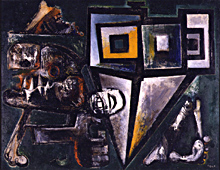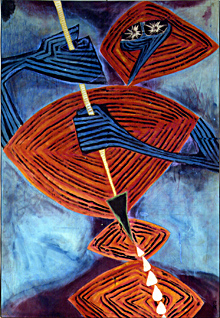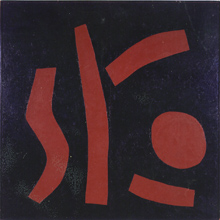1d
ルポルタージュ、密室、瀧口修造と実験工房
Reportage, Closed-Door, Shuzo Takiguchi and Experimental Workshop
【本文確定】
朝鮮戦争が勃発した1950年代前半には、一方では岡本太郎の影響と、他方ではレアリスム論争が扱った問題を継承して、現実社会の緊迫した情勢を描く若手の作家たちが現れました。1953年の第1回ニッポン展に「あけぼの村物語」を出品した山下菊二や、中村宏、池田龍雄、利根山光人らは、共産党が関わった各地の米軍基地反対闘争などを実地取材によって土着的に描き、「ルポルタージュ絵画」と呼ばれました。あるいは、そのように正面から現実に立ち向かうのではなく、観念的で非情な画面を通して逆説的に現実に関わろうとする作家も登場し、第1回ニッポン展に「浴室シリーズ」を出品した河原温や、石井茂雄、小山田二郎らは、「密室の絵画」と呼ばれました*1d1。
「ルポルタージュ絵画」も「密室の絵画」も手法的にはシュルレアリスムの延長でしたが、同時代には山口長男や村井正誠等、抽象芸術系の画家たちの活動も見られました。その中でも特異な存在は、1951年に若手の美術家や音楽家、文学者の総合芸術グループとして東京で結成された「実験工房」でした*1d2。命名は詩人評論家の瀧口修造で*1d3、完璧さよりは冒険的な「実験」、芸術家個人のアトリエよりは共同作業者たちの「工房」たろうとし、1953年の実験工房第5回展ではテープレコーダーやオートスライド等、最新のテクノロジーを駆使して、日本のテクノロジー・アートとしての最初の成果を挙げました。
ところで、既成の公募団体による画壇構造に批判的な瀧口修造はかねてから個展という発表形式を重視していましたが、1951年より東京神田のタケミヤ画廊の顧問を無報酬で引き受けることとなりました。そして1957年まで計201回、新進作家の個展やグループ展の企画に携わりました。実験工房やそのメンバーのみならず、1949年に始まった読売アンデパンダン展で登場してきた新人の紹介を数多く行い、きたるべき反芸術の時代への布石とした格好となりました。
「読売アンデパンダン展」(アンパン)についても触れておきます*1d4。業界大手の読売新聞社の主催により東京都美術館で毎年2月か3月に開催された同展は*1d5、企画サイド内部にも、「無審査、無賞、自由出品」というアンデパンダン方式によって、「既成の公募団体を潰す」という過激な意識をもった海藤日出男なる仕掛人がいました。本節で言及した多数の若手たちはいわゆる「アンデパンダン作家」の第1世代、すなわち既成の公募団体には属さずに、個展と読売アンデパンダン展を主要な発表の場として活動するようになった新人作家群でした。
In the early 1950s when the Korean War broke out, some young artists came to depict tense situations of contemporary society, who were influenced by OKAMOTO Taro (岡本太郎) on the one hand, and succeeded the Realism Controversy on the other hand. Their works became called "Reportage Painting," among which YAMASHITA Kikuji (山下菊二) is known for "Akebono Village Story" shown at the 1st Nippon Exhibition, besides other painters like NAKAMURA Hiroshi (中村宏), IKEDA Tatsuo (池田龍雄), or TONEYAMA Kojin (利根山光人). They went to the scenes of conflicts like communist-led protesters against US military bases, painting those stories in indigenous fashion. Meanwhile, other young artists had begun attempts to grasp the reality paradoxically through notional and apathetic paintings instead of dealing with the immediate reality. Their works became called "Closed-Door Painting," among which KAWARA On (河原温) is known for "Bathroom Series" shown at the 1st Nippon Exhibition, besides other painters like ISHII Shigeo (石井茂雄) or OYAMADA Jiro (小山田二郎)*1d1.
While "Reportage Painting" and "Closed-Door Painting" were both extended from surrealism in terms of techniques, there were also painters rather close to abstract art such as YAMAGUCHI Takeo (山口長男) or MURAI Masanari (村井正誠). The most outstanding among those was a synthetic art group, the "Experimental Workshop," formed in Tokyo in 1951 by young artists, musicians and writers*1d2. In preference for adventurous "experiments" than perfection and for a co-workers' "workshop" than artists' individual ateliers, the groups was named so by the poet and critic TAKIGUCHI Shuzo 瀧口修造*1d3, marking first achievement of technology art in Japan in their making full use of the latest technologies like tape recorders or auto slide in the 5th Experimental Workshop Exhibition in 1953.
Takiguchi Shuzo (瀧口修造), having favored the style of the solo-exhibition critically against to the art circle structure composed of established contest-organizations, came to take charge of the curation for free at the Takemiya Gallery in Kanda, Tokyo. At the gallery where solo and group exhibitions of up-and-comming artists from 1951 to 1957 were counted up to 201 in total, he introduced not only the Experimental Workshop and its members, but also numerous newcomers who had emerged in the Yomiuri Independent Exhibition launched in 1949 as if to have laid foundations for the forthcoming era of anti-art.
The above-mentioned Yomiuri Independent Exhibition needs special attention*1d4. Persisting in the independent style of "no jury, no prize, and open to everybody," the Yomiuri Independent Exhibition (abbreviated "Anpan") was held every February or March at the Tokyo Metropolitan Art Museum under the auspices of a major newspaper publisher, the Yomiuri Shimbun Company*1d5. Inside the company too, there was a planner with radical ambition, KAIDO Hideo (海藤日出男), who regarded the independent style as "crushing the established contest-organizations." Many young artists mentioned in this section were the first generation of so-called "Independent Exhibition Artists," who came to present their works mainly at solo exhibitions or the Yomiuri Independent Exhibition without belonging to any established contest-organization.









